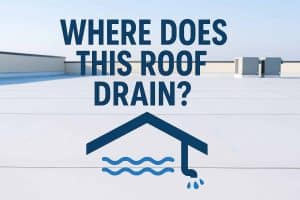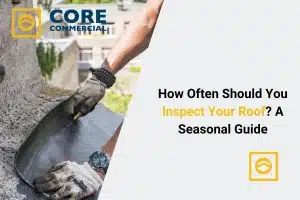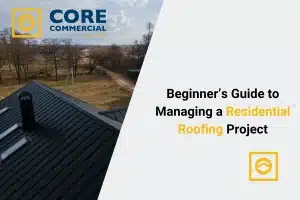Texas roofs face a serious beating year-round. From blistering summer heat to sudden downpours and hailstorms, it’s no surprise that roof leaks are one of the most common problems for commercial buildings across the state. These leaks don’t just leave stains on the ceiling—they disrupt operations, damage property, and lead to costly repairs if ignored. What’s worse? They often start small and silently do damage before you even realize there’s a problem.
One highly effective method we recommend for long-term protection is applying a silicone roof coating. This material resists ponding water and extreme UV exposure, making it one of the best solutions for flat commercial roofs in Texas. It’s a game-changer for older roofs and can delay the need for full replacement by years.
If you’re wondering how to actually stop roof leaks—not just patch them temporarily—read on. This article gives you the practical steps and real solutions building owners need to protect their roofs, their properties, and their peace of mind.

Why Roof Leaks Are a Big Deal in Texas
Texas weather can be brutal on commercial roofs. Between extreme heat, sudden thunderstorms, hailstorms, and hurricanes, it’s no wonder that leaks are one of the most common issues commercial property owners face. A roof leak isn’t just a puddle on the floor. It can damage insulation, ruin ceilings, disrupt business, and cost thousands in repairs.
Whether you own a retail store in Dallas, a warehouse in Houston, or a medical office in San Antonio, your roof needs to stand strong. That’s why understanding how to prevent leaks—and fix them fast—is critical.
Common Causes of Commercial Roof Leaks
Before you can solve a leak, it helps to know why it’s happening. In Texas, the most common reasons commercial roofs start leaking include:
- Age and wear: Roofing materials break down over time, especially under intense UV exposure.
- Poor drainage: Flat roofs often collect water, leading to ponding that causes deterioration.
- Damaged flashing: Flashing seals joints and edges—when it cracks, water gets in.
- HVAC issues: Rooftop HVAC units can leak if seals and drains are not maintained.
- Improper installation: Bad work during the original build or repair can lead to chronic issues.
- Severe weather: Hail, high winds, and debris can all tear or puncture roofing materials.
Now, let’s break down the top 10 solutions that stop roof leaks before they become disasters.
Solution 1: Regular Roof Inspections
Don’t wait until water is dripping from the ceiling. Schedule roof inspections at least twice a year—once in the spring and again in the fall. Texas summers and storm seasons are tough, and early detection can save you thousands.
A professional inspector can:
- Identify minor issues before they turn into expensive problems
- Check flashing, seams, and roof membranes
- Spot signs of damage caused by weather, pests, or mechanical systems
Benefit: Stay ahead of the problem, extend your roof’s life, and reduce emergency repair costs.
Solution 2: Fix Flashing and Seals Immediately
Flashing is the metal that seals joints around vents, skylights, and roof edges. If it’s loose, corroded, or cracked, water will find a way inside. The same goes for sealants around pipes and rooftop equipment.
In Texas, heat can dry out sealants quickly. UV rays crack rubber and caulk, making repairs urgent.
Quick fix: Use roofing-grade sealant for minor cracks. For larger gaps, replace flashing entirely.
Benefit: Prevent leaks in the most vulnerable parts of your roof.
Solution 3: Repair or Replace Damaged Roof Membranes
Most commercial roofs use membranes like TPO, PVC, or modified bitumen. When these get torn or blistered, they allow water to seep underneath. Wind, hail, and foot traffic can all cause damage.
Have a roofer repair small tears with heat welding or adhesive patches. If the damage is widespread, replacement may be the smarter investment.
Benefit: Keep the waterproof barrier intact and avoid long-term structural damage.
Solution #4: Clean and Maintain Gutters and Drains
Clogged drains and gutters are a silent leak risk. When water has nowhere to go, it sits on the roof and slowly breaks it down. Leaves, dirt, and roofing debris block water flow, especially after storms.
Make it a habit to:
- Clean out gutters at least quarterly
- Check scuppers and internal drains
- Install screens to keep out leaves and birds
Benefit: Avoid water buildup that leads to leaks, mold, and even roof collapse.
Solution 5: Use High-Quality Roofing Materials for Repairs
It’s tempting to go with the cheapest option when fixing a leak. But in Texas, low-cost patches won’t hold up to the heat and weather.
Invest in:
- UV-resistant coatings
- Durable flashing materials
- Proper sealants made for Texas conditions
Pro tip: Always use materials compatible with your existing roofing system.
Benefit: Fewer repeat repairs and longer-lasting protection.
Solution 6: Address Ponding Water Issues
Flat roofs often suffer from ponding water—puddles that don’t drain within 48 hours. Over time, this wears out the roof membrane and adds unnecessary weight.
To fix ponding issues:
- Install tapered insulation to help water drain
- Add extra drainage points or scuppers
- Use roof leveling compounds
Benefit: Reduce pressure on your roof and prevent slow, hidden leaks.
Solution 7: Seal Cracks in HVAC Units and Rooftop Equipment
HVAC systems, vents, solar panels, and satellite dishes all penetrate the roof, and every penetration is a potential leak point. Seals around units often degrade due to heat and vibration.
Check for:
- Cracked caulk or sealant
- Rusted equipment bases
- Standing water around mechanical units
Have a technician reseal, re-caulk, or replace damaged components as needed.
Benefit: Keep your roof’s biggest risk areas water-tight and energy-efficient.
Solution 8: Reinforce Roof Coatings for Extra Protection
A roof coating acts like sunscreen for your building. It reflects UV rays, seals minor cracks, and adds an extra layer of defense against water. This is especially helpful for older roofs that aren’t ready for full replacement.
Popular options in Texas include:
- Silicone coatings for ponding resistance
- Acrylic coatings for UV protection
- Polyurethane for impact and traffic durability
Benefit: Extend your roof’s life by up to 10 years with a single application.
Solution 9: Install a Leak Detection System
Want to catch leaks the moment they happen? Consider installing an electronic leak detection system. These tools use sensors to detect moisture and alert you before it becomes visible inside the building.
Some systems even work with your building automation controls.
Good for: Large warehouses, hospitals, and data centers.
Benefit: Catch leaks early, save money, and avoid business disruptions.
Solution 10: Plan for Long-Term Roof Replacement
At some point, repairs stop being cost-effective. If your commercial roof is over 20 years old and you’re seeing recurring leaks, it’s time to start planning for a full replacement.
Modern roofing systems are more energy-efficient and better equipped to handle Texas weather than ever before.
Steps to plan:
- Get quotes from multiple commercial roofing contractors
- Choose the right system (TPO, PVC, metal, etc.)
- Consider insulation upgrades and ventilation improvements
Benefit: Peace of mind, better energy performance, and long-term savings.
Final Thoughts: Stay Ahead of Roof Leaks in Texas
Stopping a commercial roof leak isn’t about quick fixes—it’s about smart maintenance, quality materials, and long-term thinking. Texas weather doesn’t forgive neglect. But with these 10 strategies, you can stay dry, avoid surprise costs, and keep your business running smoothly.
FAQs
How do I fix a commercial roof leak in Texas?
To fix a commercial roof leak in Texas, start by identifying the leak’s source, which may be due to damaged flashing, ponding water, or membrane issues. Then, clean the area and apply appropriate repairs, such as sealing cracks or replacing damaged materials. Regular maintenance and inspections can prevent future leaks.
What causes commercial roof leaks in Texas?
Common causes of commercial roof leaks in Texas include extreme weather conditions like heavy rain and hail, aging roofing materials, poor installation, clogged gutters, and lack of regular maintenance. These factors can lead to water infiltration and damage.
How can I prevent roof leaks on my commercial building?
Prevent roof leaks by scheduling regular inspections, cleaning gutters and drains, repairing minor damages promptly, and ensuring proper installation of roofing materials. Regular maintenance helps identify and address potential issues before they escalate.
What is the best roofing material for Texas commercial buildings?
In Texas, durable roofing materials like TPO (Thermoplastic Olefin), PVC (Polyvinyl Chloride), and metal roofs are popular for commercial buildings due to their resistance to heat, UV rays, and severe weather conditions. Choosing the right material depends on your building’s specific needs and budget.
How often should I inspect my commercial roof in Texas?
It’s recommended to inspect your commercial roof at least twice a year, preferably in the spring and fall. Additionally, inspections should be conducted after major weather events to identify and address any damage promptly.
What are the signs of a leaking commercial roof?
Signs of a leaking commercial roof include water stains on ceilings or walls, mold or mildew growth, dripping water, and increased energy bills. Regular inspections can help detect these issues early and prevent extensive damage.
Can ponding water cause roof leaks in Texas?
Yes, ponding water, which occurs when water accumulates on flat roofs, can lead to leaks. In Texas, heavy rains can exacerbate this issue. Proper drainage systems and regular maintenance are essential to prevent water accumulation and roof damage.
Are roof coatings effective for preventing leaks?
Roof coatings can be effective in preventing leaks by providing an additional protective layer against UV rays and water infiltration. They can extend the life of your roof when applied correctly and maintained regularly.
What should I do immediately after discovering a roof leak?
Upon discovering a roof leak, move any equipment or furniture away from the affected area, place containers to catch dripping water, and contact a professional roofing contractor to assess and repair the damage promptly. Documenting the damage can also be helpful for insurance claims.
How does Texas weather impact commercial roofs?
Texas weather, characterized by extreme heat, heavy rains, and occasional hailstorms, can cause roofing materials to expand, contract, and deteriorate over time. Regular maintenance and using weather-resistant materials can mitigate these effects.






